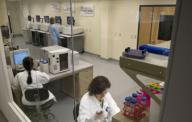| Laboratory systems | |||
One million base pairs of Neandertal DNA sequenced22 November 2006 Branford, Conn., USA. A comparison of the human and chimpanzee genomes to Neandertal DNA sequences determined by 454 Sequencing reveals that modern human and Neandertal DNA sequences diverged on average about 500,000 years ago and the effective size of the ancestral population of the two groups was similar to that of modern humans. The publication is the impetus of the collaboration with the Max Planck Institute of Evolutionary Anthropology to sequence the complete Neandertal genome. The research is published in the journal Nature.
"Direct high-throughput 454 Sequencing of a DNA extract from a Neandertal fossil has thus far yielded a significant portion of the Neandertal genome, including over one million base pairs of hominoid nuclear DNA sequences, giving us the confidence to commence with the sequencing of the entire Neandertal genome," explained Svante Paabo, Ph.D., Director of the Department of Evolutionary Anthropology at the Max Planck Institute and lead author of the Nature article. "Sequencing the Neandertal genome offers the unique possibility to identify genetic changes specific to the genome of anatomically fully modern humans."</p> A parallel study on the same Neandertal sample also appears online in the journal Science this week. "The study was performed with conventional library preparation and more than 90% of the base pairs generated were from 454 Sequencing," continued Dr. Paabo, co-author of the Science paper. "We believe the publication of articles in both Nature and Science is further validation of 454 Sequencing technology and demonstrates that we are the emerging gold standard for broad, fast and accurate sequencing of any genome, even one from highly degraded samples," said Christopher McLeod, President and CEO of 454 Life Sciences. "We believe that the Neandertal genome promises to yield more insight into human biology than the sequencing of any individual human." Due to contamination of fossil samples by microbial DNA, the task of sequencing the Neandertal genome is much more extensive than the task of sequencing the human genome. 454 Life Sciences' Genome Sequencer 20 System makes such an endeavor feasible by allowing approximately a quarter of a million single DNA strands from small amounts of bone to be sequenced in only about five hours by a single machine. The DNA sequences determined by the Genome Sequencer 20 system are 100-200 base pairs in length, which coincides neatly with the length of ancient DNA fragments. The Max Planck Society's decision to fund the project is based on the analysis of approximately one million base pairs of nuclear Neandertal DNA from a 38,000-year-old Croatian fossil. Over the next two years, the Neandertal sequencing team plans to reconstruct a draft of the 3 billion bases that made up the genome of Neandertals. An intermediate goal will be the completion of the Neandertal mitochondrial genome which will provide answers to the question of maternal Neandertal DNA contribution to present day human DNA.
|
